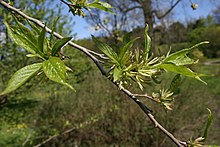
The Rubiaceae are a family of flowering plants, commonly known as the coffee, madder, or bedstraw family. It consists of terrestrial trees, shrubs, lianas, or herbs that are recognizable by simple, opposite leaves with interpetiolar stipules and sympetalous actinomorphic flowers. The family contains about 13,500 species in about 620 genera, which makes it the fourth-largest angiosperm family. Rubiaceae has a cosmopolitan distribution; however, the largest species diversity is concentrated in the tropics and subtropics. Economically important genera include Coffea, the source of coffee, Cinchona, the source of the antimalarial alkaloid quinine, ornamental cultivars, and historically some dye plants.
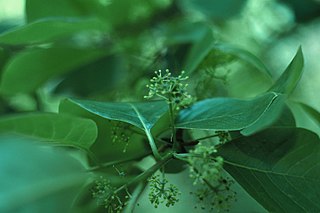
Tupelo, genus Nyssa, is a small genus of deciduous trees with alternate, simple leaves. It is sometimes included in the subfamily Nyssoideae of the dogwood family, Cornaceae, but is placed by other authorities in the family Nyssaceae. In the APG IV system, it is placed in Nyssaceae.

Sassafras is a genus of three extant and one extinct species of deciduous trees in the family Lauraceae, native to eastern North America and eastern Asia. The genus is distinguished by its aromatic properties, which have made the tree useful to humans.

The Ulmaceae are a family of flowering plants that includes the elms, and the zelkovas. Members of the family are widely distributed throughout the north temperate zone, and have a scattered distribution elsewhere except for Australasia.

Theaceae, the tea family, is a family of flowering plants comprising shrubs and trees, including the economically important tea plant, and the ornamental camellias. It can be described as having from seven to 40 genera, depending on the source and the method of circumscription used. The family Ternstroemiaceae has been included within Theaceae; however, the APG III system of 2009 places it instead in Pentaphylacaceae. Most but not all species are native to China and East Asia.
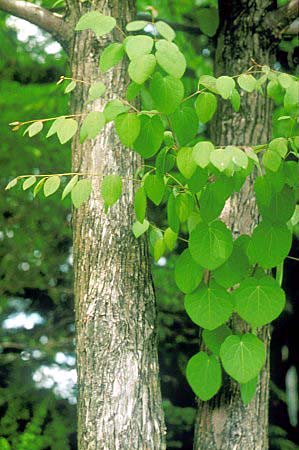
Cercidiphyllum is a genus containing two species of plants, both commonly called katsura. They are the sole members of the monotypic family Cercidiphyllaceae. The genus is native to Japan and China and unrelated to Cercis (redbuds).

Garryaceae is a small family of plants known commonly as the silktassels. It contains two genera:

Eucommia ulmoides is a species of small tree native to China. It belongs to the monotypic family Eucommiaceae. It is considered vulnerable in the wild, but is widely cultivated in China for its bark and is highly valued in herbology such as traditional Chinese medicine.

Ticodendron incognitum is the only species of Ticodendron, and the only member of the family Ticodendraceae. It is most closely related to the family Betulaceae.

Tetracentron is a genus of flowering plant with a sole living species being Tetracentron sinense and several extinct species. It was formerly considered the sole genus in the family Tetracentraceae, though it is now included in the family Trochodendraceae together with the genus Trochodendron.
Paleontology or palaeontology is the study of prehistoric life forms on Earth through the examination of plant and animal fossils. This includes the study of body fossils, tracks (ichnites), burrows, cast-off parts, fossilised feces (coprolites), palynomorphs and chemical residues. Because humans have encountered fossils for millennia, paleontology has a long history both before and after becoming formalized as a science. This article records significant discoveries and events related to paleontology that occurred or were published in the year 1940.

Eucommia eocenica is an extinct species of flowering plant in the family Eucommiaceae. E. eocenica is known from fossil fruits found in the middle Eocene Claiborne Formation deposits of the southeastern United States. E. eocenica is one of five described fossil species from North America assigned to the modern genus Eucommia. The other species are E. constans, E. jeffersonensis, E. montana, and E. rowlandii.
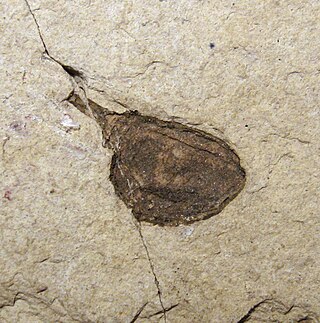
Eucommia montana is an extinct species of flowering plant in the family Eucommiaceae. E. montana is known from fossil fruits found in Eocene deposits of the northwestern United States southeastern British Columbia south to Oregon and east to Montana and Colorado. E. montana is one of five described fossil species from North America assigned to the modern genus Eucommia. The other species are E. constans, E. eocenica, E. jeffersonensis, and E. rowlandii.
Eucommia constans is an extinct species of flowering plant in the family Eucommiaceae. Eucommia is a genus of small trees now native to China, with a fossil record that shows a much wider distribution. E. constans is known from fossil fruits found in Miocene to Pleistocene deposits of east-central Mexico. E. constans is one of five described fossil species from North America assigned to the modern genus Eucommia. The other species are E. eocenica, E. jeffersonensis, E. montana, and E. rowlandii.
Eucommia jeffersonensis is an extinct species of flowering plant in the family Eucommiaceae. It is known from a fossil fruit found in latest Eocene deposits of Oregon, United States. E. jeffersonensis is one of five described fossil species from North America assigned to the modern genus Eucommia. The other species are E. constans, E. eocenica, E. montana, and E. rolandii.
Eucommia rolandii is an extinct species of flowering plant in the family Eucommiaceae. E. rolandii is known from four fossil leaves found in Middle Eocene deposits of British Columbia, Canada and Mississippi, United States. E. rolandii is one of five described fossil species from North America assigned to the modern genus Eucommia. The other species are E. constans, E. eocenica, E. jeffersonensis, and E. montana.
The Coldwater Beds are a geologic formation of the Okanagan Highlands in British Columbia, Canada. They preserve fossils dating back to the Ypresian stage of the Eocene period, or Wasatchian in the NALMA classification.
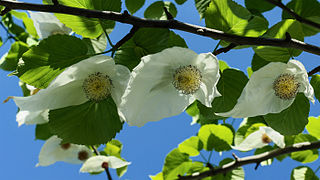
Davidia involucrata, the dove-tree, handkerchief tree, pocket handkerchief tree, or ghost tree, is a medium-sized deciduous tree in the family Nyssaceae. It is the only living species in the genus Davidia. It was previously included with tupelos in the dogwood family, Cornaceae. Fossil species are known extending into the Upper Cretaceous.
Nicobariodendron is a genus in the family Celastraceae, with only one species, Nicobariodendron sleumeri, a tree with simple, alternately set, entire leaves, small flowers and single seed fleshy fruits. It is only known from the Nicobar Islands of India.
